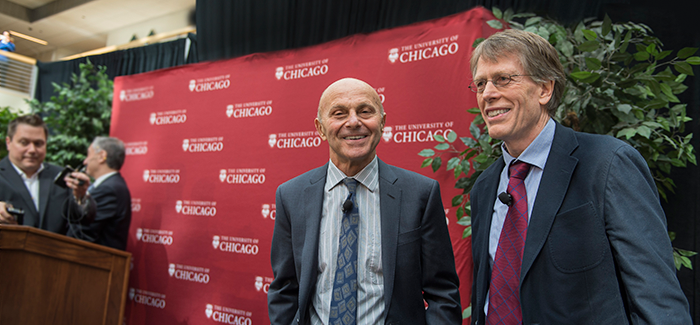
Eugene Fama, MBA’63, PhD’64, (left) and Lars Peter Hansen. (Photography by Robert Kozloff)
Fama, Hansen earn the Nobel Prize for revolutionizing how economists and investors take stock.
Lars Peter Hansen had to walk the dog before a 6:15 a.m. appointment with a personal trainer, so when the call came from Stockholm on the morning of October 14, he was awake. But he thought he might be dreaming. “First,” Hansen said later, “I wanted to make sure this was all real.”
Eugene Fama, MBA’63, PhD’64, was up preparing to teach a portfolio theory and asset pricing class when his phone rang. Fama’s economic eminence dates to the 1960s, so he could have been forgiven for anticipating the news, but after brushing his teeth he told the Chicago Sun-Times, “It’s a surprise.”
Hansen and Fama were informed that, along with Yale’s Robert Shiller, they had received the 2013 Sveriges Riksbank Prize in Economic Sciences in Memory of Alfred Nobel “for their empirical analysis of asset prices.” They then went about their routines, interrupted only for the celebratory formalities such an accolade demands.
Arriving for a news conference a few hours later, Fama and Hansen were greeted with a standing ovation from a crowd that spilled from the Harper Center’s Rothman Winter Garden into the surrounding staircases and hallways. “Today is a great day for Chicago economics,” proclaimed John List, the Homer J. Livingston professor of economics and chair of the department.
Fama, the Robert R. McCormick Distinguished Service Professor of Finance at Chicago Booth, established the theory of efficient markets. His research demonstrated that asset prices are impossible to predict in the short term because investors cannot assimilate all the relevant information that sets those prices.
“A blindfolded monkey throwing darts” would be as effective at predicting stock fluctuations as a financial expert, economist Burton Malkiel said by way of summing up Fama’s hypothesis. “It has been repeatedly validated,” the New York Times noted in its report on the 2013 Nobel laureates, “sometimes in experiments involving actual monkeys.”
Fama’s insights about asset pricing emerged when he was a Tufts undergraduate testing a professor’s stock-market prediction methods. None of them worked. After joining the faculty of the Graduate School of Business (now Chicago Booth) 50 years ago, Fama, 74, began an academic career so influential that he has been called “the father of modern finance.”
“Whatever I am owes at least two-thirds of it, maybe three-quarters, maybe 90 percent, to the University of Chicago,” he said at the press conference. After two years abroad, Fama added, he returned with 16 papers written. He recalled sharing them with his mentor and colleague Merton H. Miller, a 1990 Nobel laureate. Reviewing the papers, Miller said, “Junk, junk, junk, junk, junk. This one’s pretty good.” Had he been in Hyde Park during that time, Fama said, Miller would have weeded out the junk before Fama wrote it.
Hansen, 60, the David Rockefeller Distinguished Service Professor in Economics, Statistics, and the College, also said he benefited from being held to an exacting academic standard, including by his students. “Most of my best students are more than happy to tell me where I’m wrong—flawed—and more than happy to expose the gaps in my understanding,” said Hansen, who also serves as research director of the Becker Friedman Institute for Research in Economics. “My graduate students over the years—current and former ones—have been some of my best colleagues.”
A University faculty member since 1981, Hansen developed the “generalized method of moments,” which helps incorporate uncertainty and information gaps into statistical models. His work is so difficult to encapsulate that, after the Nobel announcement, the New Yorker economic correspondent John Cassidy said, “Hansen’s mathematical contributions are above my pay grade,” and economics Nobelist and New York Times columnist Paul Krugman flatly stated that he had “no expertise at all” in Hansen’s econometric methods.
But those methods have wide-ranging use. “Whether it is to explore how public policies affect unemployment rates, how networks form, or how environmental regulations influence productivity growth, Lars’s work plays a key role,” List said.
Fama and Hansen become the fifth and sixth Nobel laureates among the current economics faculty, joining Roger Myerson (2007); James Heckman (2000); Robert E. Lucas Jr., AB’59, PhD’64 (1995); and Gary Becker, AM’53, PhD’55 (1992).
Fama sharing the prize with Yale’s Shiller—an economist with a contradictory view of market efficiency—reflected an ongoing debate within the discipline. “We have big important questions that remain largely open and we have giants bringing evidence to bear,” University of Michigan economist Justin Wolfers told the New York Times. “And the answer turns out to be more complicated than markets are efficient—or markets are inefficient.”
The work of marshaling and evaluating that evidence went on for the newly anointed laureates. On the day they were honored, Fama and Hansen were hopeful that their press conference would end in time to attend a talk by Chicago Booth finance professor John Cochrane on his latest research.
